Cultural Groups: Old Age, Death, Dying, and Burial Across Cultures
VerifiedAdded on 2022/10/12
|8
|2775
|439
Essay
AI Summary
This essay explores the cultural practices and beliefs surrounding old age, death, dying, and burial within three distinct cultural groups: Jewish Israelis, Gauchos from South America, and Indian culture. The essay examines how each group views and treats the elderly, including their approaches to end-of-life care, and the rituals and customs associated with death and burial. It highlights the significance of religious and cultural traditions in shaping these practices, such as the Jewish emphasis on respecting the elderly and specific burial customs, the Gaucho's traditions of respect for the natural cycle of life, and the diverse Indian cultural practices influenced by Hinduism and Buddhism. The analysis covers topics like the perception of old age, the handling of the dying, funeral processes, and the role of family and community in these sensitive times. The essay provides a comparative analysis of these cultural perspectives, emphasizing the diversity in beliefs and practices while also pointing out common themes of respect, care, and remembrance. The research draws upon academic sources to support the discussion of each cultural group's unique approach to these fundamental aspects of human life.

RUNNING HEAD: CULTURAL GROUPS 0
Cultural Groups
Student’s Details-
9/24/2019
Cultural Groups
Student’s Details-
9/24/2019
Paraphrase This Document
Need a fresh take? Get an instant paraphrase of this document with our AI Paraphraser
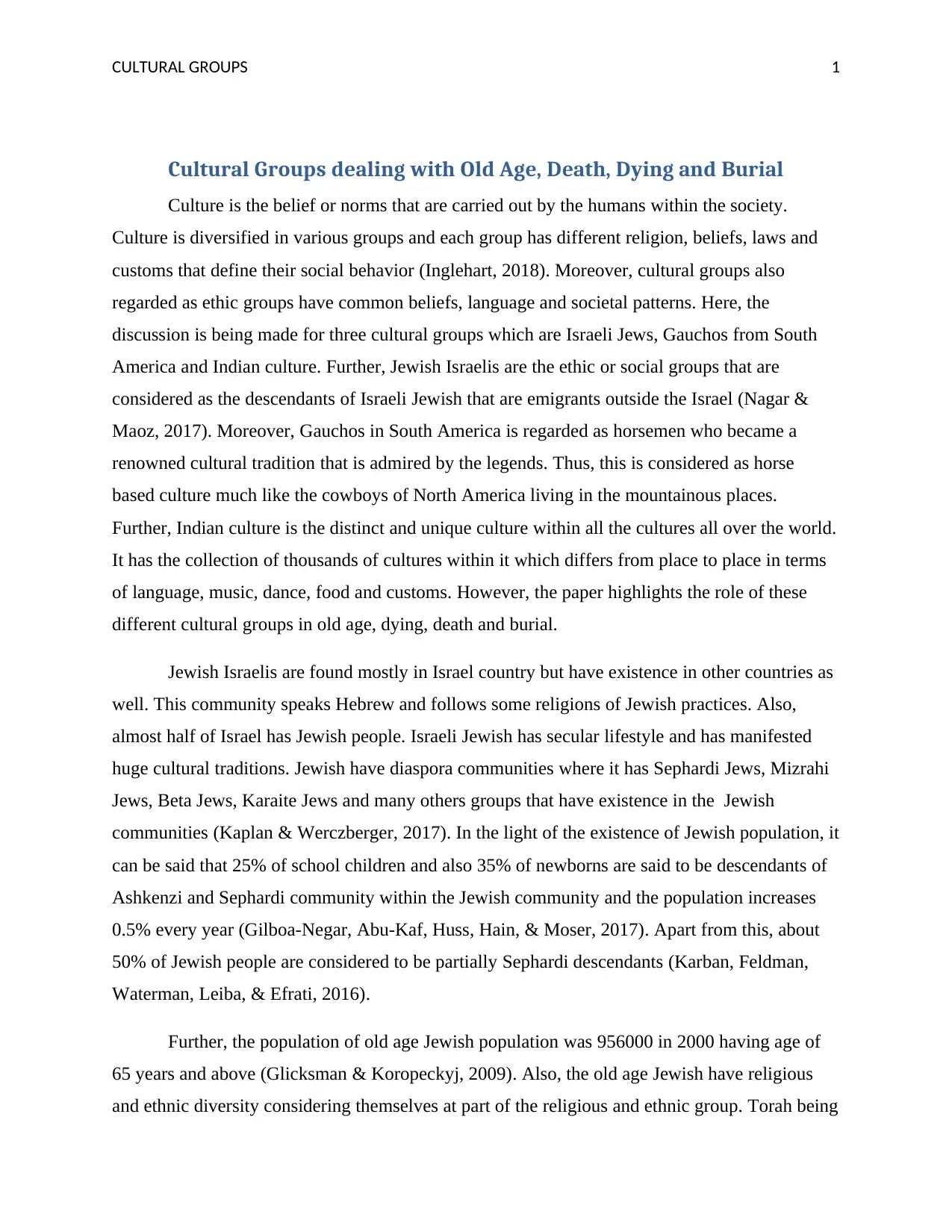
CULTURAL GROUPS 1
Cultural Groups dealing with Old Age, Death, Dying and Burial
Culture is the belief or norms that are carried out by the humans within the society.
Culture is diversified in various groups and each group has different religion, beliefs, laws and
customs that define their social behavior (Inglehart, 2018). Moreover, cultural groups also
regarded as ethic groups have common beliefs, language and societal patterns. Here, the
discussion is being made for three cultural groups which are Israeli Jews, Gauchos from South
America and Indian culture. Further, Jewish Israelis are the ethic or social groups that are
considered as the descendants of Israeli Jewish that are emigrants outside the Israel (Nagar &
Maoz, 2017). Moreover, Gauchos in South America is regarded as horsemen who became a
renowned cultural tradition that is admired by the legends. Thus, this is considered as horse
based culture much like the cowboys of North America living in the mountainous places.
Further, Indian culture is the distinct and unique culture within all the cultures all over the world.
It has the collection of thousands of cultures within it which differs from place to place in terms
of language, music, dance, food and customs. However, the paper highlights the role of these
different cultural groups in old age, dying, death and burial.
Jewish Israelis are found mostly in Israel country but have existence in other countries as
well. This community speaks Hebrew and follows some religions of Jewish practices. Also,
almost half of Israel has Jewish people. Israeli Jewish has secular lifestyle and has manifested
huge cultural traditions. Jewish have diaspora communities where it has Sephardi Jews, Mizrahi
Jews, Beta Jews, Karaite Jews and many others groups that have existence in the Jewish
communities (Kaplan & Werczberger, 2017). In the light of the existence of Jewish population, it
can be said that 25% of school children and also 35% of newborns are said to be descendants of
Ashkenzi and Sephardi community within the Jewish community and the population increases
0.5% every year (Gilboa-Negar, Abu-Kaf, Huss, Hain, & Moser, 2017). Apart from this, about
50% of Jewish people are considered to be partially Sephardi descendants (Karban, Feldman,
Waterman, Leiba, & Efrati, 2016).
Further, the population of old age Jewish population was 956000 in 2000 having age of
65 years and above (Glicksman & Koropeckyj, 2009). Also, the old age Jewish have religious
and ethnic diversity considering themselves at part of the religious and ethnic group. Torah being
Cultural Groups dealing with Old Age, Death, Dying and Burial
Culture is the belief or norms that are carried out by the humans within the society.
Culture is diversified in various groups and each group has different religion, beliefs, laws and
customs that define their social behavior (Inglehart, 2018). Moreover, cultural groups also
regarded as ethic groups have common beliefs, language and societal patterns. Here, the
discussion is being made for three cultural groups which are Israeli Jews, Gauchos from South
America and Indian culture. Further, Jewish Israelis are the ethic or social groups that are
considered as the descendants of Israeli Jewish that are emigrants outside the Israel (Nagar &
Maoz, 2017). Moreover, Gauchos in South America is regarded as horsemen who became a
renowned cultural tradition that is admired by the legends. Thus, this is considered as horse
based culture much like the cowboys of North America living in the mountainous places.
Further, Indian culture is the distinct and unique culture within all the cultures all over the world.
It has the collection of thousands of cultures within it which differs from place to place in terms
of language, music, dance, food and customs. However, the paper highlights the role of these
different cultural groups in old age, dying, death and burial.
Jewish Israelis are found mostly in Israel country but have existence in other countries as
well. This community speaks Hebrew and follows some religions of Jewish practices. Also,
almost half of Israel has Jewish people. Israeli Jewish has secular lifestyle and has manifested
huge cultural traditions. Jewish have diaspora communities where it has Sephardi Jews, Mizrahi
Jews, Beta Jews, Karaite Jews and many others groups that have existence in the Jewish
communities (Kaplan & Werczberger, 2017). In the light of the existence of Jewish population, it
can be said that 25% of school children and also 35% of newborns are said to be descendants of
Ashkenzi and Sephardi community within the Jewish community and the population increases
0.5% every year (Gilboa-Negar, Abu-Kaf, Huss, Hain, & Moser, 2017). Apart from this, about
50% of Jewish people are considered to be partially Sephardi descendants (Karban, Feldman,
Waterman, Leiba, & Efrati, 2016).
Further, the population of old age Jewish population was 956000 in 2000 having age of
65 years and above (Glicksman & Koropeckyj, 2009). Also, the old age Jewish have religious
and ethnic diversity considering themselves at part of the religious and ethnic group. Torah being
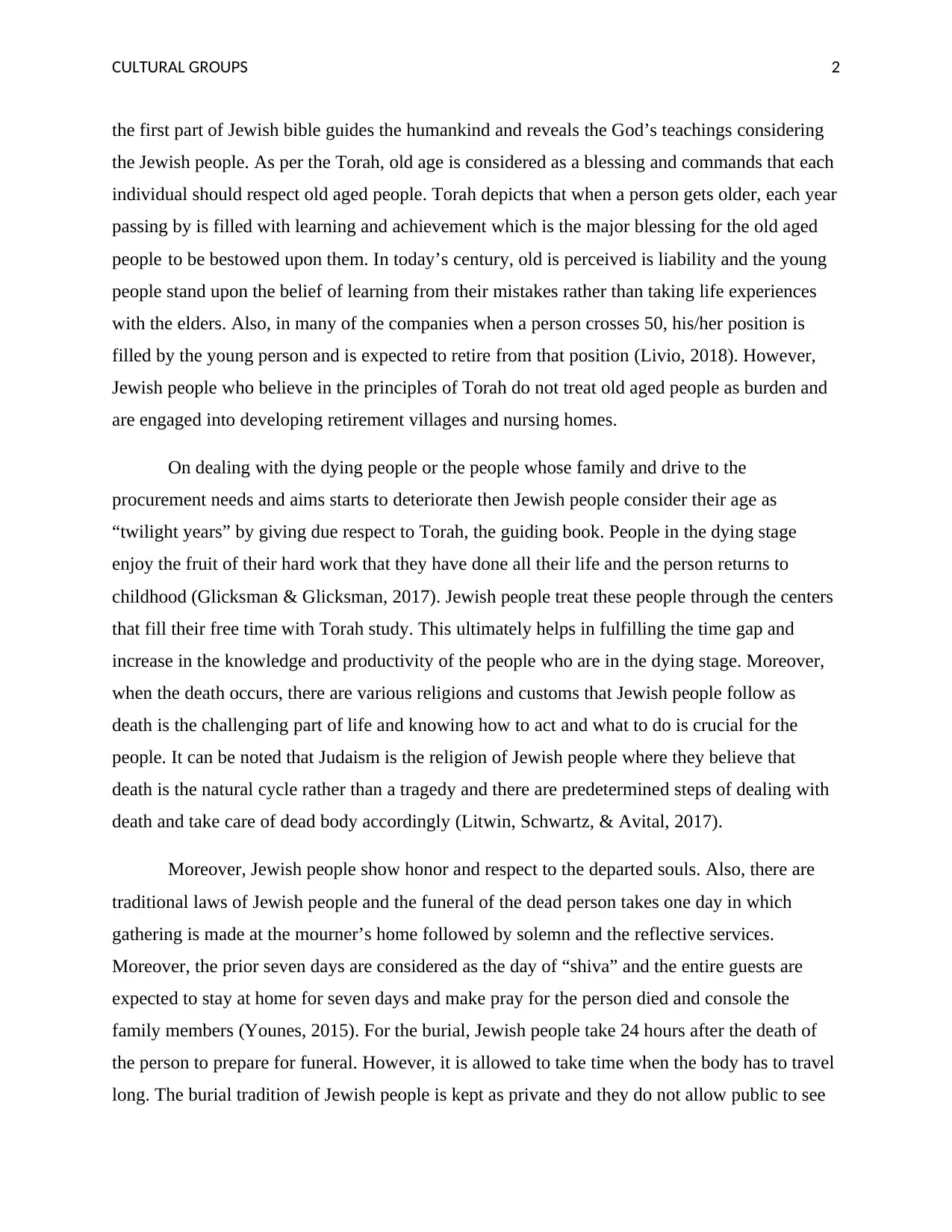
CULTURAL GROUPS 2
the first part of Jewish bible guides the humankind and reveals the God’s teachings considering
the Jewish people. As per the Torah, old age is considered as a blessing and commands that each
individual should respect old aged people. Torah depicts that when a person gets older, each year
passing by is filled with learning and achievement which is the major blessing for the old aged
people to be bestowed upon them. In today’s century, old is perceived is liability and the young
people stand upon the belief of learning from their mistakes rather than taking life experiences
with the elders. Also, in many of the companies when a person crosses 50, his/her position is
filled by the young person and is expected to retire from that position (Livio, 2018). However,
Jewish people who believe in the principles of Torah do not treat old aged people as burden and
are engaged into developing retirement villages and nursing homes.
On dealing with the dying people or the people whose family and drive to the
procurement needs and aims starts to deteriorate then Jewish people consider their age as
“twilight years” by giving due respect to Torah, the guiding book. People in the dying stage
enjoy the fruit of their hard work that they have done all their life and the person returns to
childhood (Glicksman & Glicksman, 2017). Jewish people treat these people through the centers
that fill their free time with Torah study. This ultimately helps in fulfilling the time gap and
increase in the knowledge and productivity of the people who are in the dying stage. Moreover,
when the death occurs, there are various religions and customs that Jewish people follow as
death is the challenging part of life and knowing how to act and what to do is crucial for the
people. It can be noted that Judaism is the religion of Jewish people where they believe that
death is the natural cycle rather than a tragedy and there are predetermined steps of dealing with
death and take care of dead body accordingly (Litwin, Schwartz, & Avital, 2017).
Moreover, Jewish people show honor and respect to the departed souls. Also, there are
traditional laws of Jewish people and the funeral of the dead person takes one day in which
gathering is made at the mourner’s home followed by solemn and the reflective services.
Moreover, the prior seven days are considered as the day of “shiva” and the entire guests are
expected to stay at home for seven days and make pray for the person died and console the
family members (Younes, 2015). For the burial, Jewish people take 24 hours after the death of
the person to prepare for funeral. However, it is allowed to take time when the body has to travel
long. The burial tradition of Jewish people is kept as private and they do not allow public to see
the first part of Jewish bible guides the humankind and reveals the God’s teachings considering
the Jewish people. As per the Torah, old age is considered as a blessing and commands that each
individual should respect old aged people. Torah depicts that when a person gets older, each year
passing by is filled with learning and achievement which is the major blessing for the old aged
people to be bestowed upon them. In today’s century, old is perceived is liability and the young
people stand upon the belief of learning from their mistakes rather than taking life experiences
with the elders. Also, in many of the companies when a person crosses 50, his/her position is
filled by the young person and is expected to retire from that position (Livio, 2018). However,
Jewish people who believe in the principles of Torah do not treat old aged people as burden and
are engaged into developing retirement villages and nursing homes.
On dealing with the dying people or the people whose family and drive to the
procurement needs and aims starts to deteriorate then Jewish people consider their age as
“twilight years” by giving due respect to Torah, the guiding book. People in the dying stage
enjoy the fruit of their hard work that they have done all their life and the person returns to
childhood (Glicksman & Glicksman, 2017). Jewish people treat these people through the centers
that fill their free time with Torah study. This ultimately helps in fulfilling the time gap and
increase in the knowledge and productivity of the people who are in the dying stage. Moreover,
when the death occurs, there are various religions and customs that Jewish people follow as
death is the challenging part of life and knowing how to act and what to do is crucial for the
people. It can be noted that Judaism is the religion of Jewish people where they believe that
death is the natural cycle rather than a tragedy and there are predetermined steps of dealing with
death and take care of dead body accordingly (Litwin, Schwartz, & Avital, 2017).
Moreover, Jewish people show honor and respect to the departed souls. Also, there are
traditional laws of Jewish people and the funeral of the dead person takes one day in which
gathering is made at the mourner’s home followed by solemn and the reflective services.
Moreover, the prior seven days are considered as the day of “shiva” and the entire guests are
expected to stay at home for seven days and make pray for the person died and console the
family members (Younes, 2015). For the burial, Jewish people take 24 hours after the death of
the person to prepare for funeral. However, it is allowed to take time when the body has to travel
long. The burial tradition of Jewish people is kept as private and they do not allow public to see
⊘ This is a preview!⊘
Do you want full access?
Subscribe today to unlock all pages.

Trusted by 1+ million students worldwide
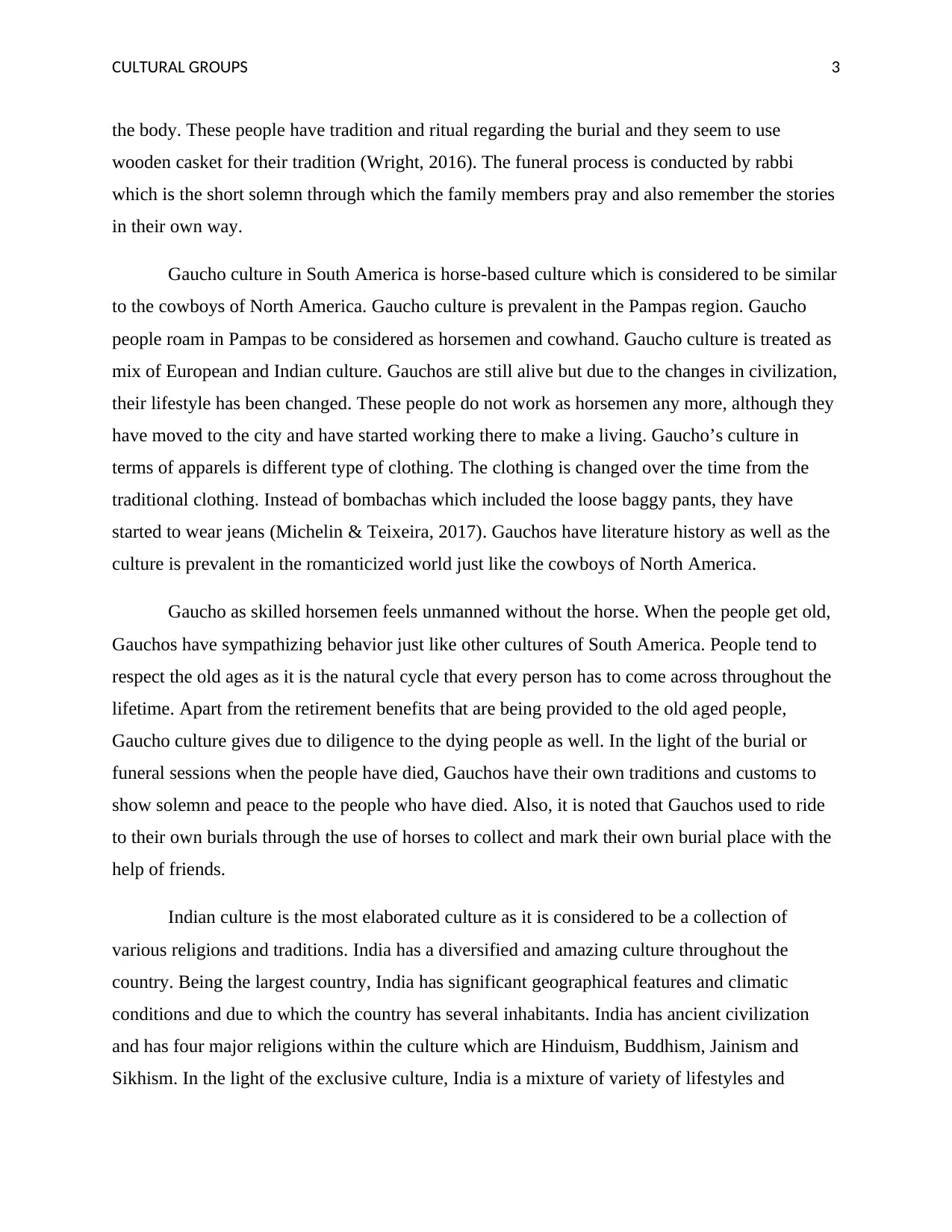
CULTURAL GROUPS 3
the body. These people have tradition and ritual regarding the burial and they seem to use
wooden casket for their tradition (Wright, 2016). The funeral process is conducted by rabbi
which is the short solemn through which the family members pray and also remember the stories
in their own way.
Gaucho culture in South America is horse-based culture which is considered to be similar
to the cowboys of North America. Gaucho culture is prevalent in the Pampas region. Gaucho
people roam in Pampas to be considered as horsemen and cowhand. Gaucho culture is treated as
mix of European and Indian culture. Gauchos are still alive but due to the changes in civilization,
their lifestyle has been changed. These people do not work as horsemen any more, although they
have moved to the city and have started working there to make a living. Gaucho’s culture in
terms of apparels is different type of clothing. The clothing is changed over the time from the
traditional clothing. Instead of bombachas which included the loose baggy pants, they have
started to wear jeans (Michelin & Teixeira, 2017). Gauchos have literature history as well as the
culture is prevalent in the romanticized world just like the cowboys of North America.
Gaucho as skilled horsemen feels unmanned without the horse. When the people get old,
Gauchos have sympathizing behavior just like other cultures of South America. People tend to
respect the old ages as it is the natural cycle that every person has to come across throughout the
lifetime. Apart from the retirement benefits that are being provided to the old aged people,
Gaucho culture gives due to diligence to the dying people as well. In the light of the burial or
funeral sessions when the people have died, Gauchos have their own traditions and customs to
show solemn and peace to the people who have died. Also, it is noted that Gauchos used to ride
to their own burials through the use of horses to collect and mark their own burial place with the
help of friends.
Indian culture is the most elaborated culture as it is considered to be a collection of
various religions and traditions. India has a diversified and amazing culture throughout the
country. Being the largest country, India has significant geographical features and climatic
conditions and due to which the country has several inhabitants. India has ancient civilization
and has four major religions within the culture which are Hinduism, Buddhism, Jainism and
Sikhism. In the light of the exclusive culture, India is a mixture of variety of lifestyles and
the body. These people have tradition and ritual regarding the burial and they seem to use
wooden casket for their tradition (Wright, 2016). The funeral process is conducted by rabbi
which is the short solemn through which the family members pray and also remember the stories
in their own way.
Gaucho culture in South America is horse-based culture which is considered to be similar
to the cowboys of North America. Gaucho culture is prevalent in the Pampas region. Gaucho
people roam in Pampas to be considered as horsemen and cowhand. Gaucho culture is treated as
mix of European and Indian culture. Gauchos are still alive but due to the changes in civilization,
their lifestyle has been changed. These people do not work as horsemen any more, although they
have moved to the city and have started working there to make a living. Gaucho’s culture in
terms of apparels is different type of clothing. The clothing is changed over the time from the
traditional clothing. Instead of bombachas which included the loose baggy pants, they have
started to wear jeans (Michelin & Teixeira, 2017). Gauchos have literature history as well as the
culture is prevalent in the romanticized world just like the cowboys of North America.
Gaucho as skilled horsemen feels unmanned without the horse. When the people get old,
Gauchos have sympathizing behavior just like other cultures of South America. People tend to
respect the old ages as it is the natural cycle that every person has to come across throughout the
lifetime. Apart from the retirement benefits that are being provided to the old aged people,
Gaucho culture gives due to diligence to the dying people as well. In the light of the burial or
funeral sessions when the people have died, Gauchos have their own traditions and customs to
show solemn and peace to the people who have died. Also, it is noted that Gauchos used to ride
to their own burials through the use of horses to collect and mark their own burial place with the
help of friends.
Indian culture is the most elaborated culture as it is considered to be a collection of
various religions and traditions. India has a diversified and amazing culture throughout the
country. Being the largest country, India has significant geographical features and climatic
conditions and due to which the country has several inhabitants. India has ancient civilization
and has four major religions within the culture which are Hinduism, Buddhism, Jainism and
Sikhism. In the light of the exclusive culture, India is a mixture of variety of lifestyles and
Paraphrase This Document
Need a fresh take? Get an instant paraphrase of this document with our AI Paraphraser
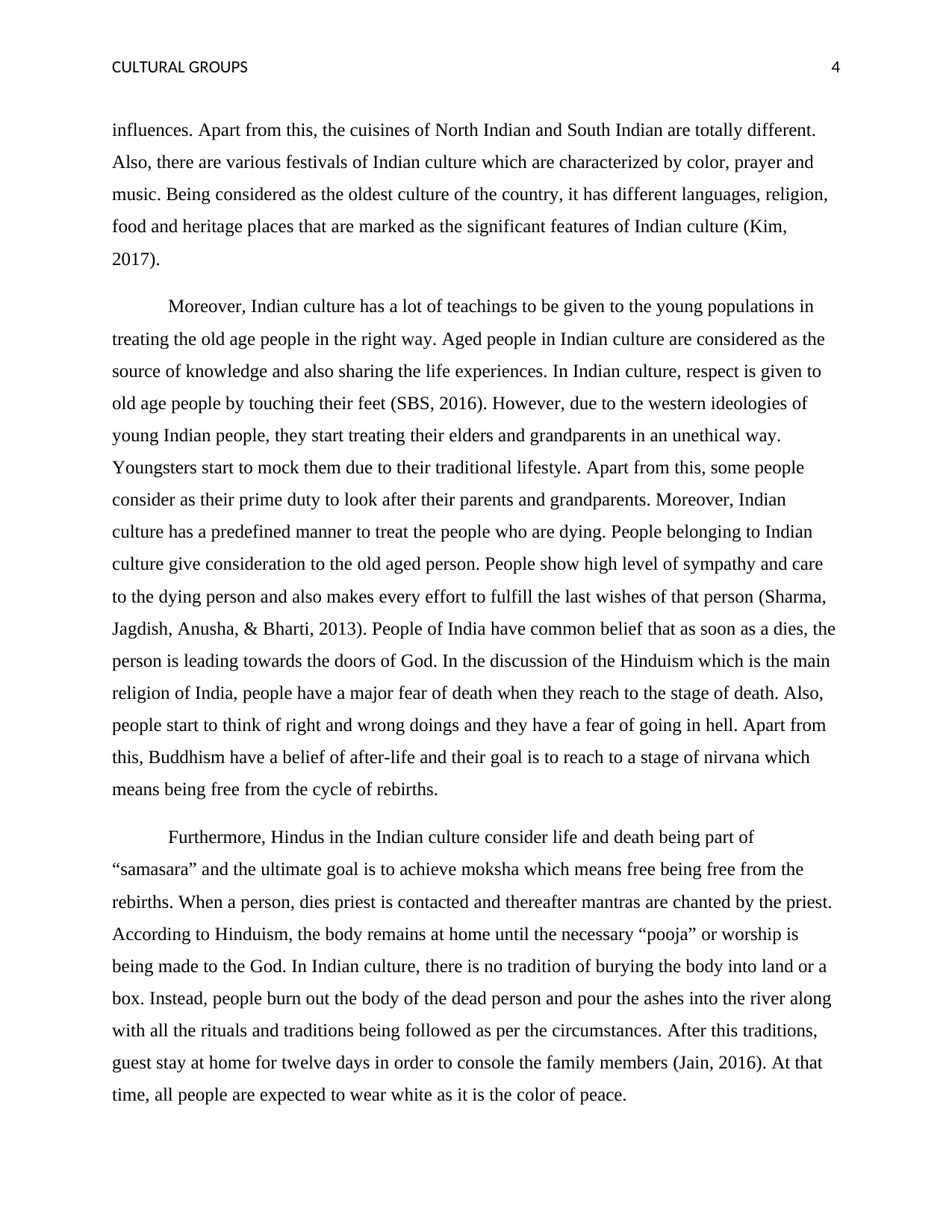
CULTURAL GROUPS 4
influences. Apart from this, the cuisines of North Indian and South Indian are totally different.
Also, there are various festivals of Indian culture which are characterized by color, prayer and
music. Being considered as the oldest culture of the country, it has different languages, religion,
food and heritage places that are marked as the significant features of Indian culture (Kim,
2017).
Moreover, Indian culture has a lot of teachings to be given to the young populations in
treating the old age people in the right way. Aged people in Indian culture are considered as the
source of knowledge and also sharing the life experiences. In Indian culture, respect is given to
old age people by touching their feet (SBS, 2016). However, due to the western ideologies of
young Indian people, they start treating their elders and grandparents in an unethical way.
Youngsters start to mock them due to their traditional lifestyle. Apart from this, some people
consider as their prime duty to look after their parents and grandparents. Moreover, Indian
culture has a predefined manner to treat the people who are dying. People belonging to Indian
culture give consideration to the old aged person. People show high level of sympathy and care
to the dying person and also makes every effort to fulfill the last wishes of that person (Sharma,
Jagdish, Anusha, & Bharti, 2013). People of India have common belief that as soon as a dies, the
person is leading towards the doors of God. In the discussion of the Hinduism which is the main
religion of India, people have a major fear of death when they reach to the stage of death. Also,
people start to think of right and wrong doings and they have a fear of going in hell. Apart from
this, Buddhism have a belief of after-life and their goal is to reach to a stage of nirvana which
means being free from the cycle of rebirths.
Furthermore, Hindus in the Indian culture consider life and death being part of
“samasara” and the ultimate goal is to achieve moksha which means free being free from the
rebirths. When a person, dies priest is contacted and thereafter mantras are chanted by the priest.
According to Hinduism, the body remains at home until the necessary “pooja” or worship is
being made to the God. In Indian culture, there is no tradition of burying the body into land or a
box. Instead, people burn out the body of the dead person and pour the ashes into the river along
with all the rituals and traditions being followed as per the circumstances. After this traditions,
guest stay at home for twelve days in order to console the family members (Jain, 2016). At that
time, all people are expected to wear white as it is the color of peace.
influences. Apart from this, the cuisines of North Indian and South Indian are totally different.
Also, there are various festivals of Indian culture which are characterized by color, prayer and
music. Being considered as the oldest culture of the country, it has different languages, religion,
food and heritage places that are marked as the significant features of Indian culture (Kim,
2017).
Moreover, Indian culture has a lot of teachings to be given to the young populations in
treating the old age people in the right way. Aged people in Indian culture are considered as the
source of knowledge and also sharing the life experiences. In Indian culture, respect is given to
old age people by touching their feet (SBS, 2016). However, due to the western ideologies of
young Indian people, they start treating their elders and grandparents in an unethical way.
Youngsters start to mock them due to their traditional lifestyle. Apart from this, some people
consider as their prime duty to look after their parents and grandparents. Moreover, Indian
culture has a predefined manner to treat the people who are dying. People belonging to Indian
culture give consideration to the old aged person. People show high level of sympathy and care
to the dying person and also makes every effort to fulfill the last wishes of that person (Sharma,
Jagdish, Anusha, & Bharti, 2013). People of India have common belief that as soon as a dies, the
person is leading towards the doors of God. In the discussion of the Hinduism which is the main
religion of India, people have a major fear of death when they reach to the stage of death. Also,
people start to think of right and wrong doings and they have a fear of going in hell. Apart from
this, Buddhism have a belief of after-life and their goal is to reach to a stage of nirvana which
means being free from the cycle of rebirths.
Furthermore, Hindus in the Indian culture consider life and death being part of
“samasara” and the ultimate goal is to achieve moksha which means free being free from the
rebirths. When a person, dies priest is contacted and thereafter mantras are chanted by the priest.
According to Hinduism, the body remains at home until the necessary “pooja” or worship is
being made to the God. In Indian culture, there is no tradition of burying the body into land or a
box. Instead, people burn out the body of the dead person and pour the ashes into the river along
with all the rituals and traditions being followed as per the circumstances. After this traditions,
guest stay at home for twelve days in order to console the family members (Jain, 2016). At that
time, all people are expected to wear white as it is the color of peace.
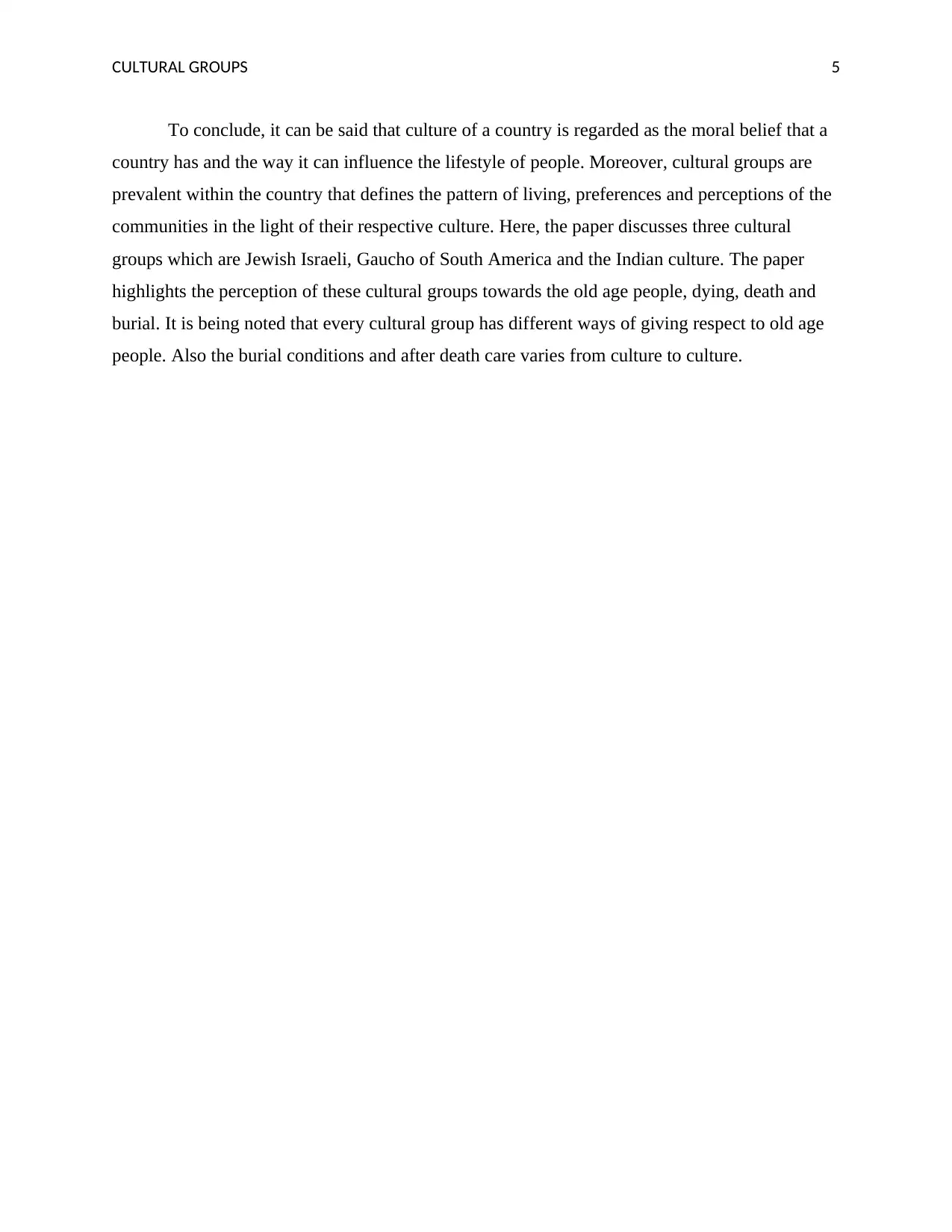
CULTURAL GROUPS 5
To conclude, it can be said that culture of a country is regarded as the moral belief that a
country has and the way it can influence the lifestyle of people. Moreover, cultural groups are
prevalent within the country that defines the pattern of living, preferences and perceptions of the
communities in the light of their respective culture. Here, the paper discusses three cultural
groups which are Jewish Israeli, Gaucho of South America and the Indian culture. The paper
highlights the perception of these cultural groups towards the old age people, dying, death and
burial. It is being noted that every cultural group has different ways of giving respect to old age
people. Also the burial conditions and after death care varies from culture to culture.
To conclude, it can be said that culture of a country is regarded as the moral belief that a
country has and the way it can influence the lifestyle of people. Moreover, cultural groups are
prevalent within the country that defines the pattern of living, preferences and perceptions of the
communities in the light of their respective culture. Here, the paper discusses three cultural
groups which are Jewish Israeli, Gaucho of South America and the Indian culture. The paper
highlights the perception of these cultural groups towards the old age people, dying, death and
burial. It is being noted that every cultural group has different ways of giving respect to old age
people. Also the burial conditions and after death care varies from culture to culture.
⊘ This is a preview!⊘
Do you want full access?
Subscribe today to unlock all pages.

Trusted by 1+ million students worldwide

CULTURAL GROUPS 6
References
Gilboa-Negar, Z., Abu-Kaf, S., Huss, E., Hain, G., & Moser, A. (2017). A cross-cultural
perspective of medical clowning: comparison of its effectiveness in reducing pain and
anxiety among hospitalized Bedouin and Jewish Israeli children. Journal of pain
research, 10, 1545.
Glicksman, A., & Glicksman, G. (2017). Introduction to the special issue on aging in the Jewish
community. Journal of Religion, Spirituality & Aging, 29(2-3), 72-74.
Glicksman, A., & Koropeckyj, T. (2009). Aging Among Jewish Americans: Implications for
Understanding Religion, Ethnicity, and Service Needs. The Gerontologist, 49(6), 816-
827.
Inglehart, R. (2018). Culture shift in advanced industrial society. Princeton University Press.
Jain, P. (2016). Dharma and ecology of Hindu communities: sustenance and sustainability.
Routledge.
Kaplan, D., & Werczberger, R. (2017). Jewish New Age and the middle class: Jewish identity
politics in Israel under Neoliberalism. Sociology, 51(3), 575-591.
Karban, A., Feldman, T., Waterman, M., Leiba, R., & Efrati, E. (2016). The association of the
MTHFR C677T polymorphism with inflammatory bowel diseases in the Israeli Jewish
population: An example of genetic heterogeneity. Medicine, 95(51).
Kim, Z. A. (2017, July 21). Indian Culture: Traditions and Customs of India. Retrieved
September 24, 2019, from live science: https://www.livescience.com/28634-indian-
culture.html
Litwin, H., Schwartz, E., & Avital, D. (2017). Religiosity and well-being among older Jewish
Israelis: Findings from SHARE. Journal of religion, spirituality & aging, 29(2-3), 208-
223.
References
Gilboa-Negar, Z., Abu-Kaf, S., Huss, E., Hain, G., & Moser, A. (2017). A cross-cultural
perspective of medical clowning: comparison of its effectiveness in reducing pain and
anxiety among hospitalized Bedouin and Jewish Israeli children. Journal of pain
research, 10, 1545.
Glicksman, A., & Glicksman, G. (2017). Introduction to the special issue on aging in the Jewish
community. Journal of Religion, Spirituality & Aging, 29(2-3), 72-74.
Glicksman, A., & Koropeckyj, T. (2009). Aging Among Jewish Americans: Implications for
Understanding Religion, Ethnicity, and Service Needs. The Gerontologist, 49(6), 816-
827.
Inglehart, R. (2018). Culture shift in advanced industrial society. Princeton University Press.
Jain, P. (2016). Dharma and ecology of Hindu communities: sustenance and sustainability.
Routledge.
Kaplan, D., & Werczberger, R. (2017). Jewish New Age and the middle class: Jewish identity
politics in Israel under Neoliberalism. Sociology, 51(3), 575-591.
Karban, A., Feldman, T., Waterman, M., Leiba, R., & Efrati, E. (2016). The association of the
MTHFR C677T polymorphism with inflammatory bowel diseases in the Israeli Jewish
population: An example of genetic heterogeneity. Medicine, 95(51).
Kim, Z. A. (2017, July 21). Indian Culture: Traditions and Customs of India. Retrieved
September 24, 2019, from live science: https://www.livescience.com/28634-indian-
culture.html
Litwin, H., Schwartz, E., & Avital, D. (2017). Religiosity and well-being among older Jewish
Israelis: Findings from SHARE. Journal of religion, spirituality & aging, 29(2-3), 208-
223.
Paraphrase This Document
Need a fresh take? Get an instant paraphrase of this document with our AI Paraphraser
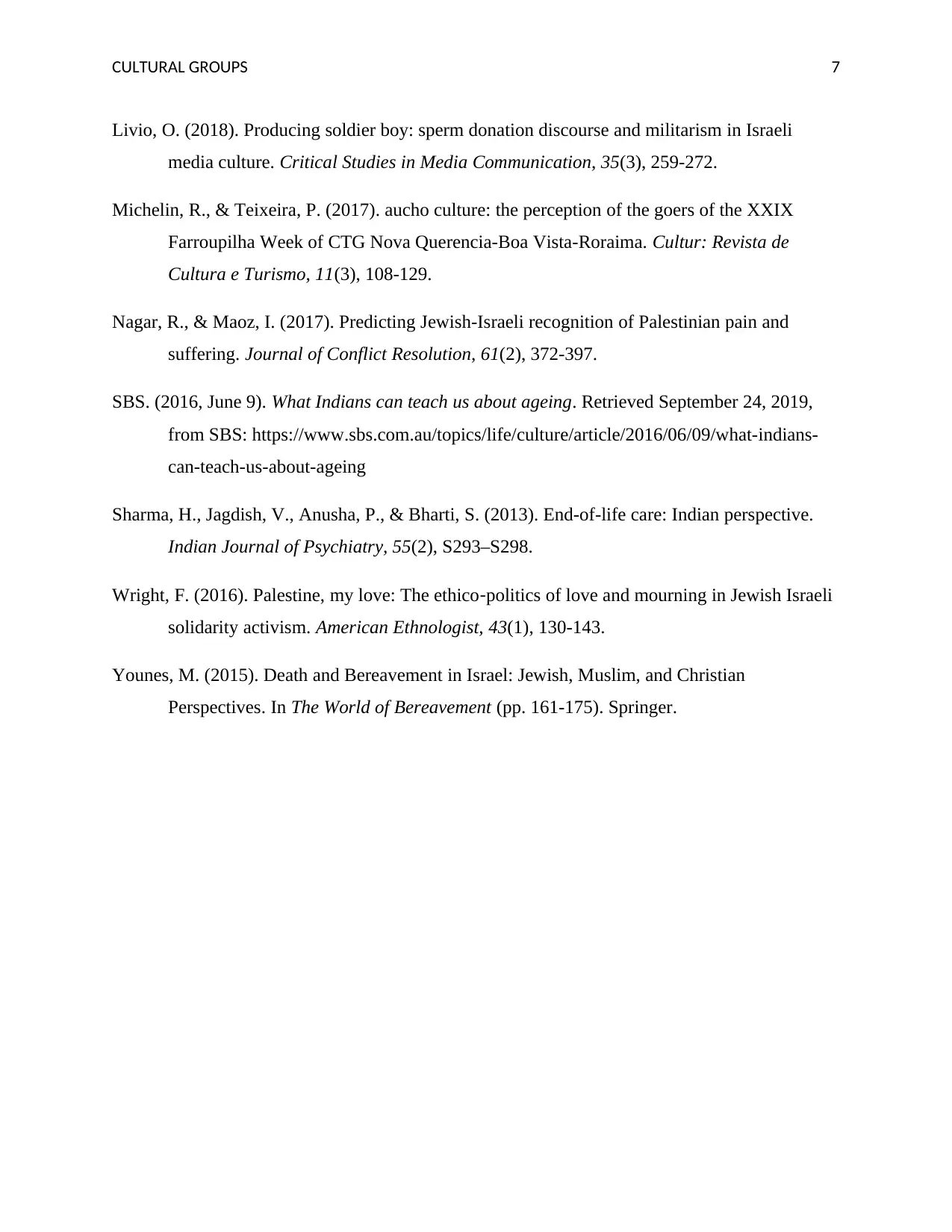
CULTURAL GROUPS 7
Livio, O. (2018). Producing soldier boy: sperm donation discourse and militarism in Israeli
media culture. Critical Studies in Media Communication, 35(3), 259-272.
Michelin, R., & Teixeira, P. (2017). aucho culture: the perception of the goers of the XXIX
Farroupilha Week of CTG Nova Querencia-Boa Vista-Roraima. Cultur: Revista de
Cultura e Turismo, 11(3), 108-129.
Nagar, R., & Maoz, I. (2017). Predicting Jewish-Israeli recognition of Palestinian pain and
suffering. Journal of Conflict Resolution, 61(2), 372-397.
SBS. (2016, June 9). What Indians can teach us about ageing. Retrieved September 24, 2019,
from SBS: https://www.sbs.com.au/topics/life/culture/article/2016/06/09/what-indians-
can-teach-us-about-ageing
Sharma, H., Jagdish, V., Anusha, P., & Bharti, S. (2013). End-of-life care: Indian perspective.
Indian Journal of Psychiatry, 55(2), S293–S298.
Wright, F. (2016). Palestine, my love: The ethico‐politics of love and mourning in Jewish Israeli
solidarity activism. American Ethnologist, 43(1), 130-143.
Younes, M. (2015). Death and Bereavement in Israel: Jewish, Muslim, and Christian
Perspectives. In The World of Bereavement (pp. 161-175). Springer.
Livio, O. (2018). Producing soldier boy: sperm donation discourse and militarism in Israeli
media culture. Critical Studies in Media Communication, 35(3), 259-272.
Michelin, R., & Teixeira, P. (2017). aucho culture: the perception of the goers of the XXIX
Farroupilha Week of CTG Nova Querencia-Boa Vista-Roraima. Cultur: Revista de
Cultura e Turismo, 11(3), 108-129.
Nagar, R., & Maoz, I. (2017). Predicting Jewish-Israeli recognition of Palestinian pain and
suffering. Journal of Conflict Resolution, 61(2), 372-397.
SBS. (2016, June 9). What Indians can teach us about ageing. Retrieved September 24, 2019,
from SBS: https://www.sbs.com.au/topics/life/culture/article/2016/06/09/what-indians-
can-teach-us-about-ageing
Sharma, H., Jagdish, V., Anusha, P., & Bharti, S. (2013). End-of-life care: Indian perspective.
Indian Journal of Psychiatry, 55(2), S293–S298.
Wright, F. (2016). Palestine, my love: The ethico‐politics of love and mourning in Jewish Israeli
solidarity activism. American Ethnologist, 43(1), 130-143.
Younes, M. (2015). Death and Bereavement in Israel: Jewish, Muslim, and Christian
Perspectives. In The World of Bereavement (pp. 161-175). Springer.
1 out of 8
Related Documents
Your All-in-One AI-Powered Toolkit for Academic Success.
+13062052269
info@desklib.com
Available 24*7 on WhatsApp / Email
![[object Object]](/_next/static/media/star-bottom.7253800d.svg)
Unlock your academic potential
Copyright © 2020–2025 A2Z Services. All Rights Reserved. Developed and managed by ZUCOL.




